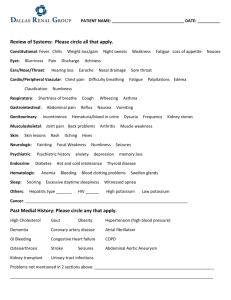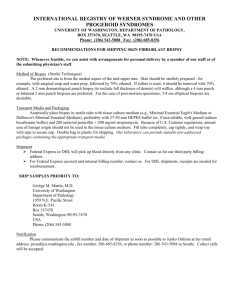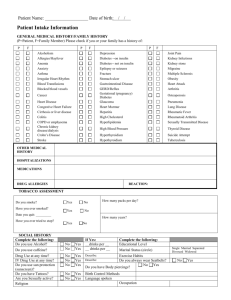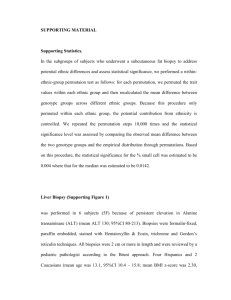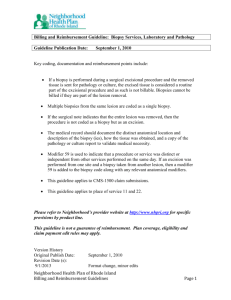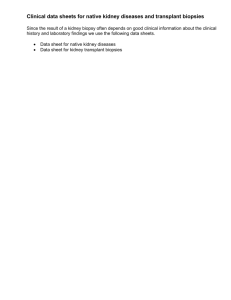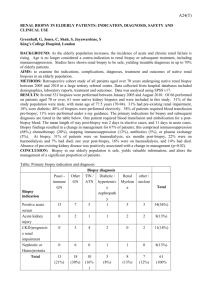Renal Biopsy Training Outline
advertisement
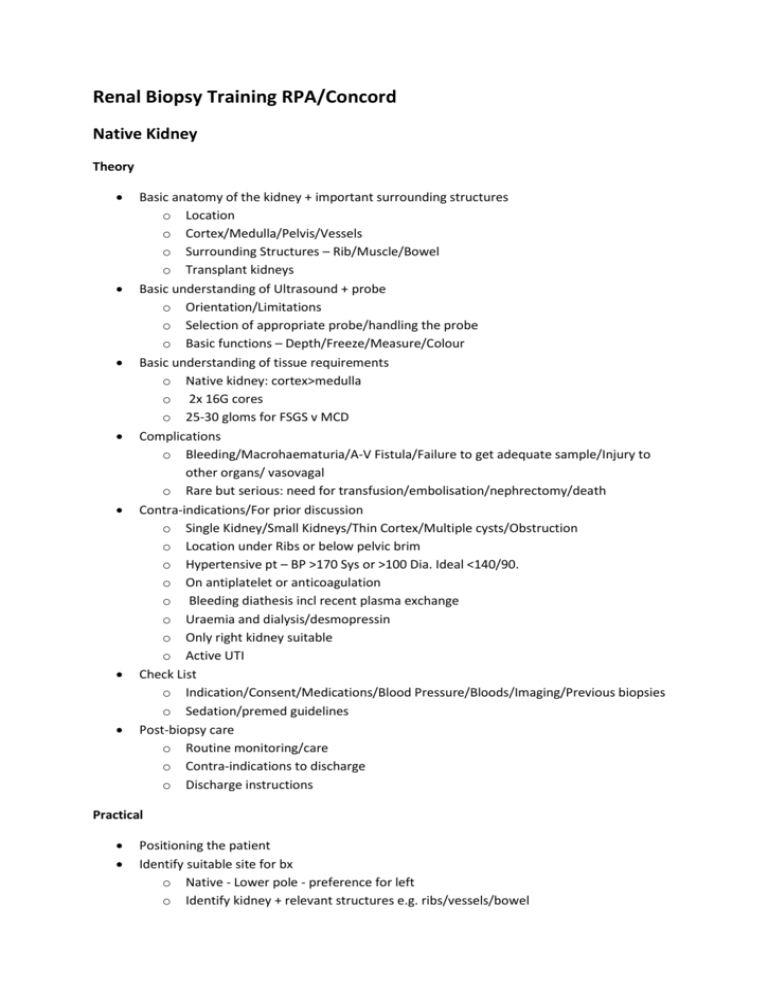
Renal Biopsy Training RPA/Concord Native Kidney Theory Basic anatomy of the kidney + important surrounding structures o Location o Cortex/Medulla/Pelvis/Vessels o Surrounding Structures – Rib/Muscle/Bowel o Transplant kidneys Basic understanding of Ultrasound + probe o Orientation/Limitations o Selection of appropriate probe/handling the probe o Basic functions – Depth/Freeze/Measure/Colour Basic understanding of tissue requirements o Native kidney: cortex>medulla o 2x 16G cores o 25-30 gloms for FSGS v MCD Complications o Bleeding/Macrohaematuria/A-V Fistula/Failure to get adequate sample/Injury to other organs/ vasovagal o Rare but serious: need for transfusion/embolisation/nephrectomy/death Contra-indications/For prior discussion o Single Kidney/Small Kidneys/Thin Cortex/Multiple cysts/Obstruction o Location under Ribs or below pelvic brim o Hypertensive pt – BP >170 Sys or >100 Dia. Ideal <140/90. o On antiplatelet or anticoagulation o Bleeding diathesis incl recent plasma exchange o Uraemia and dialysis/desmopressin o Only right kidney suitable o Active UTI Check List o Indication/Consent/Medications/Blood Pressure/Bloods/Imaging/Previous biopsies o Sedation/premed guidelines Post-biopsy care o Routine monitoring/care o Contra-indications to discharge o Discharge instructions Practical Positioning the patient Identify suitable site for bx o Native - Lower pole - preference for left o Identify kidney + relevant structures e.g. ribs/vessels/bowel o Measure distance – understand underestimate Observation of biopsy x2 Infiltrate anaesthetic superficially – x 1-2 o Identify needle with USS Infiltrate anaesthetic down to capsule x2-3 or until competent o Identify needle tip + anaesthetic in tissue planes o Locate kidney with LP needle with Pt holding breath o (Demonstrate LP needle swinging – optional) Perform biopsy with supervisor assisting/gowned x 2-3 or until competent Perform biopsy under observation x5 or until competent Perform biopsy unsupervised If no renal tissue has been sampled after 3 passes then the operator should call the treating physician for discussion All biopsies and complications to be recorded in the unit database. Importance of QA/review. Trainees are encouraged to record biopsies and complications in their own logbook. Transplant Theory Basic anatomy of the graft + surrounding structures o Cortex/Medulla/Pelvis/Vessels/Ureter o Possibility of fibrous capsule in older grafts o Surrounding Structures – Bowel/Iliac vessels/Bladder Basic understanding of Ultrasound + probe o Orientation/Limitations o Select appropriate probe/handling the probe o Basic functions – Depth/Freeze/Measure/Colour Basic understanding of tissue requirements o Cortex not medulla (some medulla desirable if looking for BK) o 1-2x 18G cores o Tissue requirements differ depending on tests required LM,IF, EM o Usually > 7 gloms Complications o Bleeding/Macrohaematuria/A-V Fistula/Failure to get adequate sample/Biopsy of other organs o Rare but serious: need for transfusion/embolisation/nephrectomy/death Contra-indications/For prior discussion o Overlaying bowel gas or fluid collection o Hypertensive pt – BP >170 or >100. Ideal <140/90. o On antiplatelet and anticoagulation o Bleeding diathesis incl recent plasma exchange o Uraemia and dialysis/desmopressin o Obstruction o Active UTI Check List o Indication/Consent/Medications/Blood Pressure/Bloods/Imaging/Previous biopsies o Sedation/pre-med guidelines Post-biopsy care o Routine monitoring/care o Contra-indications to discharge o Discharge instructions Practical Positioning the patient Identify suitable site for bx o Most superficial pole Superior preferable to lower pole o Identify graft + relevant structures - Bowel/Iliac vessels/Bladder/Fluid collections o Measure distance – understand underestimate Observation x2 Infiltrate anaesthetic– x2-3 or until competent o Identify needle with USS o Infiltrate anaesthetic down to capsule o Identify needle tip at capsule Perform biopsy with supervisor assisting/gowned x 2-3 or until competent Perform biopsy under observation x5 or until competent Perform biopsy unsupervised If no renal tissue has been sampled after 3 passes then the operator should call the treating physician All biopsies and complications to be recorded in the unit database. Importance of QA/review. Trainees are encouraged to record biopsies and complications in their own logbook. New trainees Second or third year trainees new to the hospital should present their logbook for review and be supervised at least 1-2 times to ensure they are competent. If the trainee has not performed renal transplant biopsies then they should go through training outlined above and be will be certified when competent.
